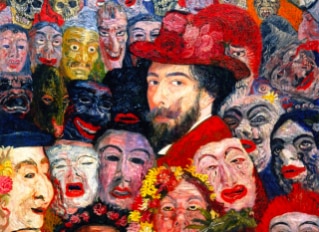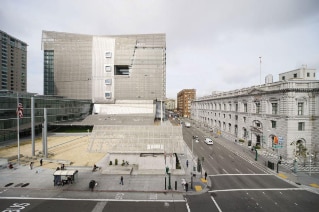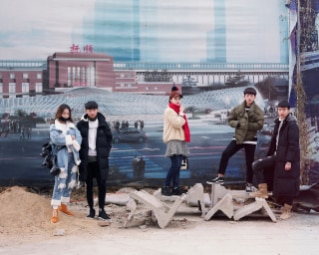Interboro, the winners of this year's MoMA-P.S.1's Young Architect Program, the prize for which is the chance to spend US$50,000 gussying up the museum's ascetic courtyard for its summer DJ series, set themselves the goal of overcoming the wall to find a different relationship between institution and neighborhood than that of party and waiting room. Their slogan: "What's Good for Long Island City is good for MoMA P.S.1!"
What they proposed was that P.S.1 itself become a waiting room of sorts for the neighborhood. As narrated by Interboro's competition drawings for its winning entry Holding Pattern released last spring, the team looked for ways to connect P.S.1 and its surroundings through a circulation of objects. Canvassing nearby businesses, schools, unions, libraries, and other local stakeholders, the designers developed a list of objects that could serve both the museum's party requirements (seating, shade, water) and neighbors' longer-term needs (mirrors for a ballet school, stools for a butterfly garden, a chaise lounge for a senior center, climbing wall for private children's gym, ping-pong tables for taxi depot, and trees for libraries, churches, schools, and cemeteries). Practicing a poetics of program, the forms of Interboro's objects materialized the desires of others: the Queensbridge Seniors Center, Teamsters Local 808, Recycle-A-Bicycle, 5Pointz Aerosol Art Center, St. George's Episcopal Church. Over the summer, the objects aimed to tie a thread between the neighborhood and the museum, and after, they will join the local material ecology.
The second big gesture of the installation was a series of silver-beribboned ropes running between the museum's parapets and courtyard walls, tracing the latent geometry of the museum's site, in a fashion similar to streamers at an auto dealership. Maybe the most excitingly intellectually aggressive component of the project, the canopy, in its immanence and empiricism, remained blissfully free of other narratives, a breezy slap at contemporary architectural manias for forms with pseudo-algorithmic backstories. Plus it looked pretty good.
The drawings were especially great, demonstrating the project's polyform and code-switching ambitions. An elevation oblique shows the canopy as a mute architectural loom webbed across the courtyard against eccentrically gabled geometry, one found form among others, underived. A set of cartoon diagrams describes object selection by criteria of "in the public interest" and "fun." Finally, a gonzo Richard-Scarry-meets-Soul-Train illustration by Lesser Gonzalez Alvarez suggests what the world might become under the influence of a project like this: where all creatures including giant chickens, dogs, old men with long hair, crocodiles with long hair, ballerina goats, and monkeys with Chinese hats get down and boogie, with no sharp distinctions between the chromatic spectacle, movement, and brontosauruses outside the museum walls and all the jamming, chilling, relaxing, and volleyball playing going on within.
In real life, some of the spaces created by the cross-fertilization of museum and neighborhood were fantastic: the snazzy mirror room was sexy and cool, and the tree room, full of wet mulch and haybales, smelled delicious. On Facebook, you can see the intimate eccentric public programs Interboro organized: an Irish Music & Dance Workshop, the 5Pointz Aerosol Art Center held a B-Boy Workshop, and a Family Summer Reading Celebration.
Other implementation choices complicated the project's impact. In a promotional video, someone mentions looking at lots of Donald Judd, and it shows. The great majority of Holding Pattern's objects, stools, benches, pools, sandboxes, picnic tables, lounges, and a lifeguard chair, are constructed in a minimal style from unpainted marine plywood. After the lead-in celebration of quirk and vernacular, such a constrained formal vocabulary is a let-down and unfortunate revenge of the tasteful upon the urban. The texture and whimsy of the receiving organizations, introduced through color photographs and paragraphs in the project's sixteen-page newspaper, feels absent from their intended objects. Ply being the go-to US material of quick and cheap fixes, you wonder how a Miesien ply chaise, no matter how high-end the material or the design reference, will be interpreted by its eventual recipients, especially after a summer of drunk dudes standing on, bashing in, and falling over it. Why didn't they just let everyone go shopping? Or try some of the figurative approaches used by firms like muf, who worked with a bricklayers' college to build a glorious 21-foot-high faux ruin in London's Barking Square, or FAT, who crafted a cartoon landscape with the facade of a community villa in Hoogvliet? Standing near the extra-big version of the Gonzalez Alvarez illustration, you could feel a bit like Dorothy gazing out over Oz while stuck in Kansas.
Why the willful austerity? In the press release, MoMA Curator Barry Bergdoll explains, "[Interboro's] work has both a modesty and a commitment quite at odds with the luxury and complex computer-generated form that has prevailed in the city in recent years." In other words, MoMA's sensitivity to the Great Recession is demonstrated by the project's position within a set of oppositions and affiliations: modesty opposed to luxury, (political? social? religious?) commitment opposed to "complex and computer-driven" shapes. Maybe plastic Ikea lamps would have hurt the vibe. In the choice between commitment and complexity, we get What Would Judd Do?, consigning objects of desire to modest utilitarian-ish expression, subduing any potential eruptions of the local within the idealized space of the museum. Why not go weirder, more ambitious? Didn't we live through postmodernism to at least get comfortable with the idea that responsive architecture need not fall victim to class-based taste formations? Instead, traditional hierarchies and their visual regimes are preserved even as they are declared overcome.
In the end, the most sensitive context for the project is institutional and the power networks structured by institutions, both at the level of MoMA/P.S.1 and that of the architecture scene. Interboro's project succeeds brilliantly as allegorical representation of its own urbanistic generation. Their drawings have already proven useful for enticing students towards the joys of extended site investigations, if not preparing them to decode the raw political fights they will find there. The celebratory tone of the project elides other questions: in New York City's most diverse borough, why feature an Irish group and several churches but few nonwhite ethnic organizations or non-Christian religious groups? These curatorial acts unwittingly trace a profile of their curators; we can imagine the challenges of connecting with the Filipino Bayanihan Seventh-day Adventist Church around the corner. Also, when the project emphasizes its precise impacts, as when the newsletter diagrams, lists, and otherwise explains each detail of the project's generosity, good intentions threaten to outshine actual impacts: of the impressive 60 intended receivers of Holding Pattern booty, so compelling in painting a picture of organizational life, 32 are scheduled to receive a single tree.
In the end, an inspirational gesture is not systemic change, and maybe Holding Pattern is too satisfied to make wonderful suggestions while respecting the distinction. After all, the politics of generosity, especially across steep gradients of power, is usually conservative. Any hopes to initiate longer-term commitments to progressive forms or progressive politics sit with the institution and not its guest architects. Next up: Foreclosed: Rehousing the American Dream, where five architecture teams take on the foreclosure crisis and the future of American living, offering another potential encounter between the stories powerful culturalists tell themselves and what lies beyond. Let's hope the MoMA's Chairman Jerry Speyer—also Chairman of Tishman-Speyer, manager of 80 million global square feet—is taking notes and giving critiques.
Damon Rich is a designer and artist, who currently serves as the Urban Designer for the City of Newark, New Jersey. His design work has been exhibited internationally.







